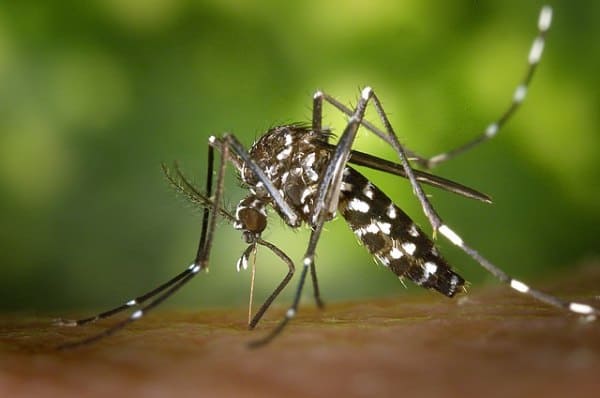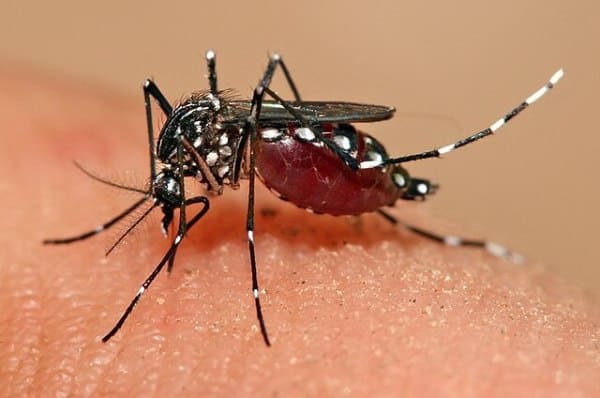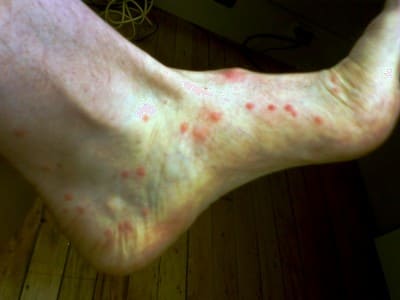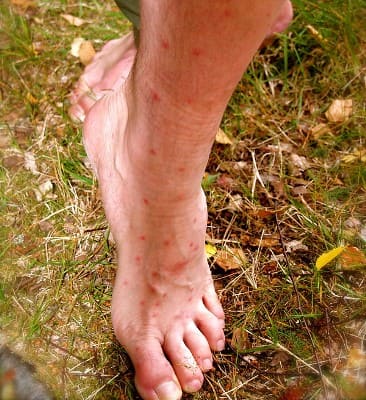Table of Contents
Ankle biter mosquitoes, as the name suggests; are aggressive biters and known for their painful bites in the exposed lower limbs especially around the ankles and feet, but they won’t spare your other exposed skin areas if you haven’t applied any ankle biter mosquito repellent.
They are the most ferocious entities during the peak mosquito season. Found mainly in the tropical and sub-tropical regions with mostly warm and humid climates.
They are small, black and white striped mosquitoes from the Aedes species, mainly Aedes albopictus (Asian Tiger Mosquito) and Aedes aegypti (Yellow fever) species. They can aggressively bite multiple times at the same place and are also active during the day.
They can’t fly any longer distances and therefore the source of their breeding spots is nearby from where they are spotted. They are known culprits for transmission of diseases like Zika virus, chikungunya, dengue, yellow fever, etc.
They can breed in very small standing waters, even a shallow water in a discarded container or object will allow them to lay their eggs. They particularly target small containers with standing waters like old tires, plant pots, bird baths, trash cans, gardening tools, rain water barrels, etc.
They mostly lay eggs on the walls of the containers. Their eggs can remain dormant and survive for more than a year in dry containers by undergoing state of dormancy. And once they get water, the eggs will hatch into larvae. This unique characteristic of ankle biter mosquitoes makes their control more challenging. Under favorable conditions, the eggs can hatch and become adults within a week of time.
What do Ankle biter mosquitoes look like?
The Aedes albopictus popularly known as Asian Tiger mosquito and the Aedes aegypti which is known for yellow fever, are the two species of ankle biter mosquitoes. They are black in colour with white striped legs and stripe on back. They also have a long striped tail as seen in the images below.


Image Credit: Wikimedia
Characteristics of Ankle biter mosquitoes (Aedes albopictus and Aedes aegypti)
- These are invasive (non-native) species of mosquitoes
- These are black mosquitoes with white stripes on their legs and back
- They prefer to live in warm, humid and temperate climates mostly in tropical regions. But they can survive in colder regions and higher altitudes as well.
- Not only humans, but they also bite pets like dogs, cats and birds like chickens.
- They fly low near the ground surface, this makes them to target areas around the ankles and feet, as this part of our body is almost exposed in many cases.
- Very aggressive with painful bites.
- Can bite multiple times at the same place causing unbearable discomfort and itching.
- Are active even during day time, preferably in shaded areas.
- Prefer to lay eggs in smaller containers and shallow waters like birdbaths, pet water bowls, discarded tires, rain water barrels, flower pots, etc.
- Their eggs can survive without water for more than a year and after receiving water the eggs can hatch into larvae.
- They need a week from hatching of eggs to becoming adult mosquitoes.

Image Credit: Canva Pro
Why do mosquitoes bite ankles?
Ankle biter mosquito bite near ankles because…
The particular mosquito species namely; Aedes albopictus and Aedes aegypti also called as ankle biter mosquitoes bite preferably at ankles and other areas around the feet. This is because of their characteristic pattern of flying low near the ground, where it is easier to access and target the uncovered or exposed skin around the lower limbs. Also the lower part of legs near feet and ankles, has thinner skin with lots of nerve endings and blood circulation; as a result this Aedes species of mosquito bites ankles more than any other areas.
As most of us prefer to keep our feet free from shoes and socks, when we are at home or in garden or backyard. And as soon as these ankle biter mosquitoes gets the slightest possible chance they attack aggressively. And if we went out without applying any repellent than they will chew our feet and legs.


Image Credit: Google images | Creative commons license
Swelling of ankles after mosquito bites
If you have got any swelling and irritation around the ankles with a red bump, than it is a ankle biter’s attack. This swelling occurs due to mosquito’s saliva that reacts with the blood and causes local inflammation. In response to this, our immune system releases histamine that causes inflammation around the bite area.
This swollen ankle after mosquito bite can be treated with a cold press. When applied immediately will soothe the bite sooner with immediate relief. It is better to apply anti-histamine cream and anti-itch creams and avoid any scratching that may lead to infection.
Ankle biter mosquito bite symptoms
If you have multiple mosquito bites after and outdoor visit or unsure about whether these are ankle biter mosquitoes, than you must check for following symptoms:
- Multiple bites around the feet near ankles as shown in the pics above
- Itchy swollen bumps or sometimes like blisters
- Dark red spots that looks like bruises
- Intolerable itching and urge to scratch
These ankle biter mosquito bite do not need any treatments, they will disappear within a week, after causing 2 to 3 days of irritation.
Where did ankle biter mosquitoes come from?
These Aedes albopictus species is originated from the tropical and sub-tropical regions of Southeast Asia, while the Aedes aegypti is believed to be originated in Africa. In few years, these species have expanded their presence across the world, because of increased transportation, globalization and changes in climate.
They were first detected in Southern California some 8 to 10 years back. People believed that they were carried here in transport and cargo ships by travelling along major shipping routes from Africa and Southeast Asia.
They travelled to different regions with favorable climate and breeding conditions and have successfully established populations in America, Europe, and Australia. They can also adapt to newer environments, which makes them capable of surviving in temperate regions.
Different Aedes species of mosquitoes that were found in United States
How long do ankle biter mosquitoes live?
The eggs of these ankle biter mosquitoes hatches and grow into adults within a week, and under favorable climatic and environmental conditions they have a very short lifecycle and can live from 2 to 4 weeks on an average. But environmental and external factors like temperature, humidity, access to food mainly bloodmeals, and presence of breeding sites with standing water.
Males have typically shorter lifecycle than females as their only purpose is to mate and promote breeding. Females mainly feed on bloodmeals and focus on developing and subsequently laying eggs and under favorable conditions can live upto a month.
The lifespan of ankle biter mosquitoes is mainly governed by the temperature of the surrounding. In warmer climates (25 to 30 oC) they have shorter lifecycle but reproduce very quickly. While, in cooler temperatures they have a longer lifespan but this slows down their rate of reproduction. While high humidity also plays a significant role in increasing their lifespan.
How to get rid of ankle biter mosquitoes?
You can identify presence and infestation of ankle biter mosquitoes in your surrounding by observing mosquito activity during daytime in shaded areas. You might see small pools of water accumulated in small containers, objects, folds of covers and tarps, etc. along with frequent mosquito bites around the ankles and feet. ‘Standing water mosquito prevention’ is the most important thing we should always give priority to.
For preventing mosquito bites and to get rid of ankle biter mosquitoes, follow the preventive and control techniques given below:
1. Prevention techniques
- Eliminate standing water or any mosquito breeding grounds
- Clean and maintain water features
- Install mosquito nets and screens
- Trim overgrown grasses and vegetation
- Clear debris and declutter your surroundings
2. Natural mosquito repellents and methods
- Natural mosquito repellents like plant based essential oil repellents (Citronella, lavender, Tea tree oil, eucalyptus oil, etc.)
- DIY Mosquito traps
- Natural mosquito predators
- DIY Mosquito control methods
3. Natural and Chemical based mosquito control methods
- Bacteria based Larvicides like BTI
- Chemical based pesticide sprays, like DEET, Picaridin, Permethrin, etc.
4. Precautionary measures for humans and pets
- Protective clothing and accessories
- Pet safe mosquito repelling agents
- Mosquito netting for patios
- Yard mosquito treatment
The above preventive and control techniques will definitely help you in getting rid of ankle biter mosquitoes.
What kills ankle biter mosquitoes?
These mosquitoes are very challenging to control and should never be neglected as they are known vectors for many fatal diseases like West Nile virus, dengue, yellow fever, Zika, chikungunya, etc. Here are some effective ways to kill these notorious pests:
- Natural insecticides: BTI (Bacillus Thirungiensis Israelensis), commonly known as mosquito dunks is the natural bacterium based larvicide that kills only the larvae and do not harm any other useful insects and animals or birds. It releases toxins that are lethal only for mosquito larvae while being safe for other organisms and aquatic life. It is the most useful method to control the population of ankle biter mosquitoes when they are at the larval stage. there are other methods also to kill mosquito larvae, as given here: What Kills Mosquito Larvae in Standing Water?
Pyrethrum, made from pyrethrin extracted from chrysanthemum flowers is also used to kill adult mosquitoes. - Chemical insecticides: Chemical based larvicides such as methoprene targets larvae in water, similar to BTI. While chemical based pyrethroids are effective adulticides, which are similar to pyrethrins that includes permethrin, sumithrin, and deltamethrin are effective in killing adult mosquitoes by ULV spraying by forming a mist (small droplets) in the air. Organophosphates like malathion and naled are also best mosquito insecticides that are being used by professionals in United States.
- Mosquito predators: Predators that prey on mosquitoes and their eggs like dragonflies, mosquitofish, guppies, goldfish, bats, spiders, frogs, and many mosquito eating birds; can be attracted or introduced in the mosquito infested zone. These mosquito predators when stocked or encouraged in sufficient numbers, are effective enough in controlling the ankle biter mosquito populations.
- Mosquito traps and Bug zappers: Mosquito traps like CO2 mosquito traps, propane traps, Yeast based mosquito traps, etc. attracts mosquitoes and capture them by luring with some smell of carbon dioxide and later kills them. Bug zappers are also very effective in instantly killing these ankle biter mosquitoes, where they attracts them through UV-A radiation and once they enter the high voltage area between the grid of the zapper, they gets electrocuted. Being a pure mechanical device these are preferred over harmful chemicals and sprays.
- Mosquito coils: Those coils which contains insecticides will kill mosquitoes or atleast knockdown, which can be killed later. And coils which contains aromatic substances or repelling agents like citronella, will only repel them.
- Mosquito foggers, Misting systems, Aerosols: The foggers or misting systems work by converting the liquid insecticide into a mist of fine particles. This dispersion of fine mist stays in the air for a certain period of time and when mosquitoes comes in contact they gets knock down. As these targets only flying mosquitoes, and are effective only when the mosquitoes comes in contact with them, therefore, timing of spray is very important.
Best ankle biter mosquito repellent
There are few mosquito repellents that works well for keeping mosquitoes at bay. While there are
- DEET
- Picaridin
- Oil of Lemon Eucalyptus (OLE)
- Tea Tree oil blended with lavender oil
Out of these, Picaridin based commercial repellent is the best ankle biter mosquito repellent after DEET.
📰 Must Read,
✔️ Home Remedies to Get Rid of Mosquito Bites Overnight
✔️ What Foods can you Eat to Repel Mosquitoes?
Conclusion
The ankle biter mosquitoes are a significant threat for humans and pets as they are responsible for diseases like dengue, West Nile virus, Zika virus, yellow fever, etc. They have a very aggressive nature and exclusive capabilities like day time activity, laying of eggs in as small as bottle-cap of water, year long survival of eggs that had been dried off before hatching, etc.
By eliminating standing waters, using physical barriers like mosquito nets and screens, introducing natural mosquito predators, and adopting both chemical as well as natural mosquito repelling methods, we can effectively control populations of these ankle biter mosquitoes.
A continuous and joint efforts from everyone in the neighborhood will definitely make the environment mosquito-free and comfortable. And you can enjoy outdoor activities without any worries of these pests bothering you anymore.
Frequently Asked Questions (FAQs)
-
Can ankle biter mosquitoes bite through clothes?
Yes, they can bite through clothing. You must wear thicker loose fitted clothing with long sleeved shirts and long length pants. Avoid wearing light colored, tight fitting short length clothing items made of thin fabric materials. Patterns like loose neck, bell sleeves, 3/4th pants and ankle length bottoms should be avoided.
-
Is salt water good for mosquito bites?
Yes, to some extent salt water may calm the irritation caused due to mosquito bites. They can also prevent infection from harmful bacteria.
-
What will stop mosquitoes biting me?
You should wear light colored, loose fitting, long sleeved clothing. If its treated with repelling agents like permethrin than it will give a long lasting protection or else you can spray home made essential oil mosquito repelling spray to repel mosquitoes. You can also change your diet as few people have claimed to get fewer bites after making some changes in their diet.

